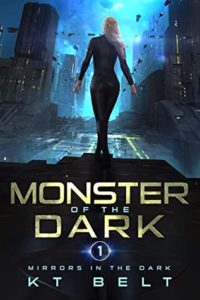
Monster of the Dark consistently garnered some of the highest scores of the first two rounds of the Self-Published Science Fiction Competition (SPSFC), with ratings of at least 8.5/10 from more than half of the judges who read it. And given its billing as a deeply psychological character study of a powerful clairvoyant taken from her family and trained to be a weapon, I was pretty excited to get to K.T. Belt’s offering.
I knew that the molding of the heroine into a weapon would be a major plot line, but genre experience had me expecting a training arc that covered the first half of the novel before the second half opened up into the use of that training. I was mistaken—Monster of the Dark follows Carmen from the day she was taken from her family to the time that her training was completed, with half of the novel detailing the brutal shaping of her combat abilities and mental acuity, followed by the shaping of the way she relates to the less gifted everyday folk.
Unfortunately, Monster of the Dark never came together for me, for a number of reasons. The prose matured as the character aged, but I had trouble getting into the flow in the early chapters where Carmen was quite young, and I never understood why the simpler prose continued even in the sections written from the perspective of the handlers. I also struggled to connect to Carmen’s emotional development, which consisted mostly in brutal training scenes, punctuated by short introspective sections and time skips. The training sequences certainly provided plenty of fodder for trauma, but it sometimes felt as though seeing the traumatizing event on the page was used as a shortcut to establish the lead’s mental state without requiring convincing introspection. There was one scene in particular whose brutality seemed to serve no purpose other than to shock and appall.
Upon reflection, the inconsistency in Carmen’s emotional development partially stems from an inconsistency in the motivations of the group doing the training. It is established that they are clairvoyants themselves who were abused by an alien enemy and seek to build up the new generation as a credible threat should war return. It is also established that they rely in part on methods of torture that were used on themselves. So far, so good—they want killing machines, and they inherited some unsavory training techniques to that end. But that setup makes the second half of the novel deeply puzzling. If they want killing machines, why do they care whether clairvoyants can integrate with ordinary human society? Why are they worried about whether or not their trainees will ever be able to serve in non-military roles? And if the interest in societal integration is genuine, why the physical and psychological torture of the novel’s first half?
It’s no secret that fear of war is the animating concern driving the series that opens with Monster of the Dark, and the book appears to set the stage for a conflict that I expect to happen in the second book. But if war is to be the main theme, the training-centric first book is merely prologue. And–even setting aside the wisdom of opening a series with an extended introduction–it doesn’t really work as a prologue. I could perhaps understand it as a prequel, allowing superfans the chance to see the origin story of an established heroine. But without enough context to pin down the motivations of Carmen’s handlers, the entire training sequence seems confused and disjointed. And that makes for an inconsistent origin story that produces a few quality scenes but generally makes it hard to invest in what’s coming next.
Can I use it for Bingo? It’s hard mode for Self-Published and Mental Health (and Award Finalist, if it doesn’t win) by (I believe) a BIPOC Author who Uses Initials.
Overall rating: 8 of Tar Vol’s 20. Two stars on Goodreads.
SPSFC score: 4/10 for my personal score. We will await results from the other judges before announcing an official team score.
